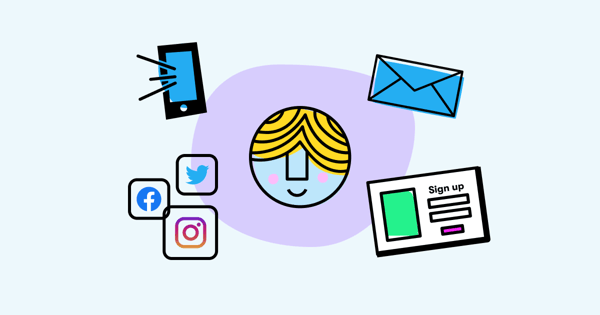Multichannel marketing is kind of a no brainer — multiple channels will always be more effective than just one.
According to research from Digital Doughnut and EPiServer, 95 percent of marketers agree that taking a multichannel approach plays an important role in achieving their business goals. Presumably, the other five percent didn’t understand the question.
Of course, knowing to use more than one channel isn’t much on its own. Successful multichannel marketing is all about how you leverage those channels to develop and execute an effective marketing strategy.
The same study found that three in five marketers lack the ability to understand a prospect’s position on the customer journey.
One-quarter lack confidence in their ability to deliver “the right message, at the right time, to the right prospect.”
It doesn’t matter which channels you use — you still need to understand your audience and deliver relevant messaging. If you’re having trouble getting the right results from multichannel marketing, you’re in the right place.

Multichannel Marketing 101:
What is Multichannel Marketing?
Multichannel marketing is simple to define: it’s the practice of using more than one channel to market your brand. These channels can be digital, like a Facebook page, a Twitter feed or an email list, or they can be traditional, like billboards, signs in a metro or subway, newspaper ads, etc. They can even be TV commercials, or "snail mail" catalogues.
Let’s say you’re launching a new product and want to generate interest. You might start by promoting its features, benefits, and launch date to your social media followers and email subscribers.
Next, you could start running social ads and set up a dedicated landing page to capture search traffic. Perhaps you’d even take things offline with a print, broadcast, or direct mailer campaign.
That all sounds great, but it doesn’t necessarily mean you’re running an effective multichannel campaign. Here are a few points to keep in mind:
How to Build a Multichannel Marketing Strategy
1. Nail the messaging
Multichannel or no, marketing ultimately comes down to messaging. No amount of multichannel integration can make up for bland copy or a forgettable brand.
Small businesses often have trouble with consistency after delegating different channels to different teams. A clear style guide and shared mission will help keep your team on the same page.
So where do you start?
What’s the pain point you solve for your customer? How do they describe the problem in their own words?
Knowing how your customers talk about their problems is the foundation of your whole marketing strategy and messaging.
For example, let’s say in your niche, you serve customers who want a very particular kind of home decor. So you sell decor that’s a bit interesting, or unique. It’s not stuff you’d find at IKEA (nothing wrong with IKEA — they single-handedly furnished my first apartment).
The problem that you solve might be, in the words of your customer: “I want my home to reflect my unique personality, and I want it to be unique.”
You’d then use that narrative throughout your messaging. Maybe your site, ads, social posts, and etc. would be something like “Unique home decor that reflects you.”
This is a very basic example, but that core problem that you solve is your North Star. It’s the one thing that should be central to all of your channels, which will help you create a killer multichannel strategy.
2. Channels to Leverage in Multichannel Marketing
Identifying the right marketing channels is tricky. Even just picking which social media platforms to prioritize can be tricky.
Think about it this way: does it make sense for you to spend time and energy on a channel where your customers aren’t active?
For example, if you sell apparel online, you might do better with Instagram, TikTok, and Facebook. Email and social ads will likely be big revenue drivers and audience builders.
But if you’re selling more DIY/homewares, you might have success on those channels, but you might do even better on Pinterest and YouTube.
If you’re having trouble allocating resources, consider starting with these categories:
- Organic search: Organic search traffic won’t come in overnight, but it can provide a long-term, sustainable boost to lead generation. A site with high search rankings will continue to bring in visitors on its own while you focus on other projects.
- Social media: Each social media platform has pros and cons, but you need to have some kind of social presence. Remember to provide links to your social profiles on your website, email signature, and other content.
- Email: Even though it isn’t the sexiest marketing channel these days, email continues to quietly deliver results. 99% of people check their emails every day, and more than half of all Americans check their emails over ten times per day.
Paid search, SMS, and push notifications are solid alternatives, but you can’t go wrong with any of the three above. Over time, you’ll get the real-world results you need to see what works and what doesn’t.
The whole purpose of using more than one channel is to increase your reach, so you need to use the channels that’ll help you get in front of your target audience.
Really consider your different channels, the content you can create for them, and whether or not your customer base uses those channels.
3. Drive engagement
Lots of brands start social media marketing by making scheduled posts or posting about specific events.
Those aren’t necessarily bad, but they’re also not enough. Likes, comments, shares, and other forms of engagement are just as important as views.
People want to see you genuinely engaging with your audience rather than just posting content to meet a quota.
How can you drive engagement? Ask. It’s really that simple.
Will it work all the time? No.
But you can’t expect a customer to engage with you if you don’t ask them to. It’s pretty simple: ask them what they think.
For example, when we publish an email breakdown on social media, we ask our audience to post a screenshot of their favorite emails.
Then, we engage with every single comment in some way.
If you have trouble getting engagement at first, have your employees and colleagues comment and drive some engagement. It’s no secret that social posts with engagement get even more engagement — that’s how social algorithms work.
Even in our newsletter, we encourage engagement: we ask for replies instead of clicks, purchases, etc.
And the results?
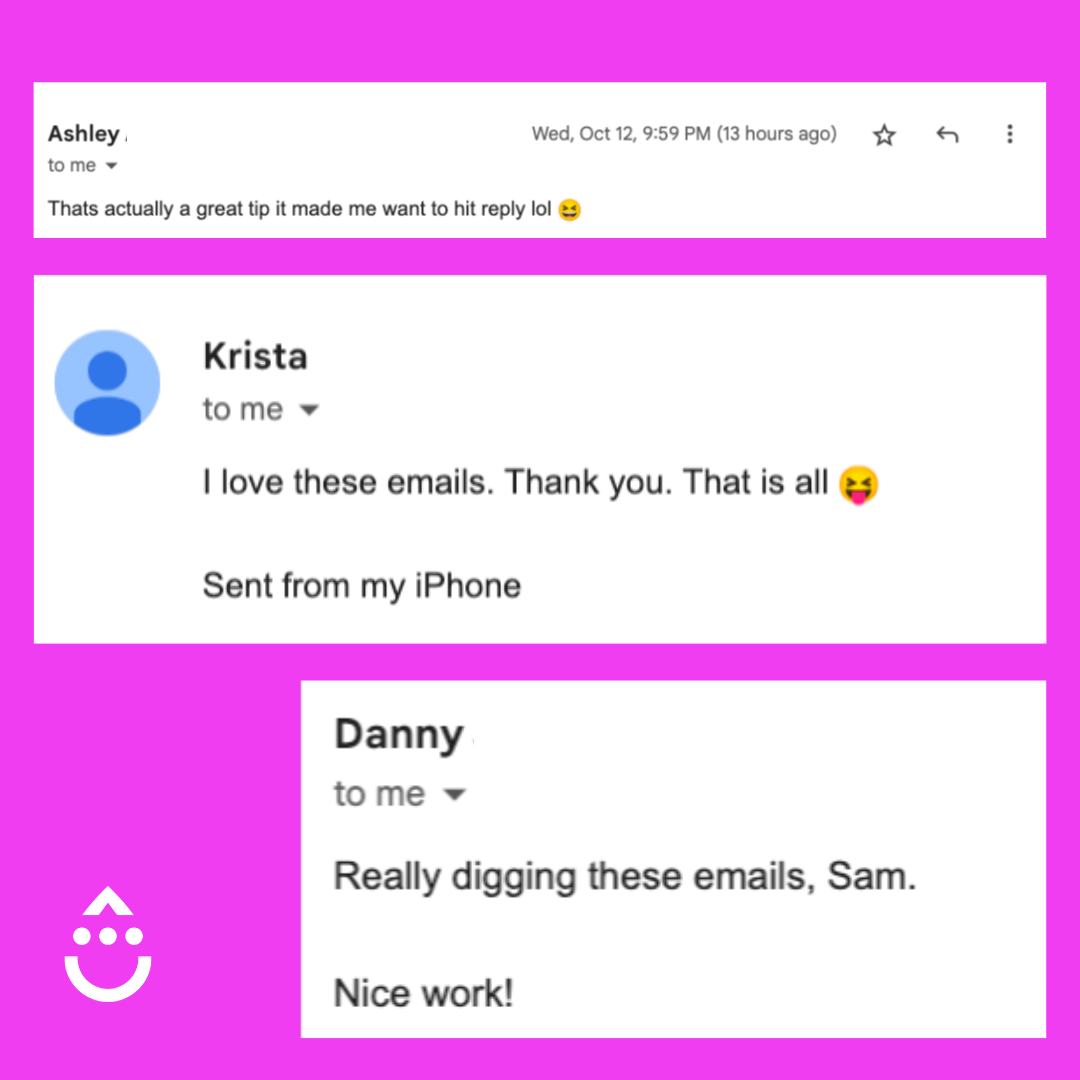 Multichannel marketing is about starting a conversation with your customers. Instead of talking at your customers, you want to talk with them.
Multichannel marketing is about starting a conversation with your customers. Instead of talking at your customers, you want to talk with them.
4. Be integrated
Part of running an effective multichannel campaign is knowing how to make the different pieces fit together.
If you simply run the same messaging on each channel, you’re missing an opportunity and wasting money on inefficient targeting.
If you want to integrate, you need to gather data from various sources.
Someone clicks on your social ad and buys a product? Make sure to exclude them from any upcoming emails about the same product.
Maybe they click but they don’t purchase? Be sure to integrate retargeting ads on different channels to keep the product that originally interested them in front of their eyes.
Even on a baseline, if someone takes advantage of your welcome offer, make sure they’re not seeing the welcome pop up the next time they visit.
It’s got to make sense for your customers — that’s how you create a cohesive multichannel marketing strategy.
Benefits and Challenges of Multichannel Marketing
In the end, you should start running multichannel campaigns because they will help you reach your goals.
There are clear benefits to using a multichannel marketing strategy:
- Reach: If you only advertise on one channel, you’re limiting your audience to the people who use that channel. Your customers use more than just one channel to shop — so you need to bring your marketing to where they are.
- Customer experience: From your site, to your socials, to your campaigns, and customer service, your customer wants a unified experience across the board. Using a multichannel strategy unifies your channels under a single message that’s consistent throughout your sales funnel, leading to a better customer experience.
- Sales: Put simply, connecting with your audience on more channels increases the odds that they’ll become a customer. Harvard Business Review found that nearly 75% of retail customers engaged on multiple channels before making a purchase.
Marketing is complex enough on its own, but it gets even more confusing when you start working with multiple channels.
Just because multichannel marketing is a good thing doesn’t mean it’s easy. Most companies encounter some combination of these challenges as they develop more sophisticated tactics:
- Resources: Multichannel marketing sounds great: just add some new channels and watch the users roll in. Unfortunately, it isn’t that simple. Do you have the time and money to build powerful messaging and a great experience across all of those channels? If not, consider starting small and adding more channels over time.
- Integration: Sending someone the same irrelevant ad three times won’t bring them any closer to making a purchase. Multichannel marketing only works if the channels come together for a cohesive, logical customer experience.
- Attribution: Identifying where sales are coming from isn’t always easy in a complex multichannel workflow. With so much varied data coming in, you need to be able to cut through the noise and make the right adjustments based on new information.
Why Companies Are Shifting to Omnichannel Marketing
As shown by Google Search Trends, multichannel was a key concept for marketers throughout the 2000s and into the 2010s. Omnichannel finally caught up in around 2017 and has become much more relevant in recent years.
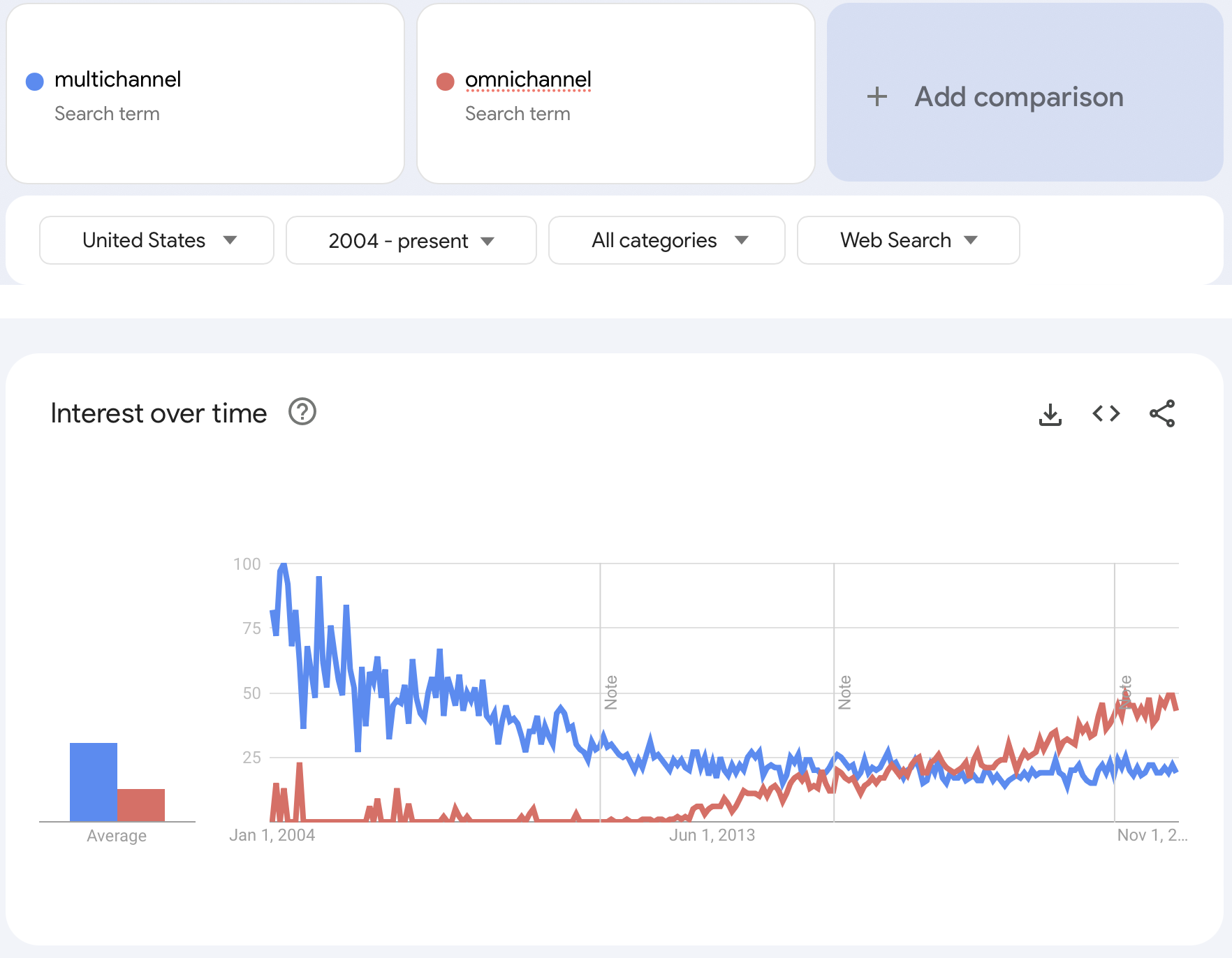 In short, omnichannel marketing is a multichannel strategy that focuses more on the integrated aspect of modern marketing campaigns. Omnichannel campaigns often involve sophisticated workflows that involve triggers, actions, and data from customer interactions across all channels.
In short, omnichannel marketing is a multichannel strategy that focuses more on the integrated aspect of modern marketing campaigns. Omnichannel campaigns often involve sophisticated workflows that involve triggers, actions, and data from customer interactions across all channels.
The key advantage of omnichannel marketing is putting the customer at the center of your strategy.
Amazon is a great example — they collect as much information as they legally can (if not more), then use it to sell to you with perfect precision. You might see a search ad, Facebook ad, and email ad all in one day.
That may not be a realistic goal for a typical small business, but the same concepts apply regardless of scale. The more channels you can use to seamlessly interact with a lead, the more connected they’ll begin to feel to your brand.
5 Killer Multichannel Marketing Examples
Okay, so we understand the theory behind what “good multichannel marketing” looks like. Now, let’s dig into some real-world examples of killer multichannel marketing campaigns.
1. Allbirds
I’ve already noted that consistency is one of the key elements of successful multichannel marketing. It’s the reason you only need to catch a distant glimpse of the famous “golden arches” to immediately start craving a Big Mac.
Consistent messaging isn’t just a nice-to-have; it has specific and practical business benefits. In a survey of more than 400 brand management experts, Lucidpress predicted businesses that consistently maintain their brand enjoy a 10-20 percent uptick in revenue.
However, it appears that consistency is easier said than done, with just 30 percent of brands routinely enforcing their own guidelines.
Simply put, if your marketing communications aren’t consistent, don’t expect to see results. You need to figure out the combination of visuals, messaging, and language that resonates with your audience—and once you’ve found it, you need to do more of it.
Which is precisely what Kiwi-American footwear and apparel brand Allbirds does.
Allbirds consistently leverages two key messages in its marketing:
- Sustainability
- Comfort
Importantly, those aren’t just empty words. The brand has committed to reducing its carbon footprint to near-zero by 2030, and its products are made with natural materials like merino wool and eucalyptus fiber.
This shines through in its marketing, regardless of channel. For instance, check out this recent Facebook ad for the “world’s most comfortable shoes,” which also references how they’re made from natural materials:
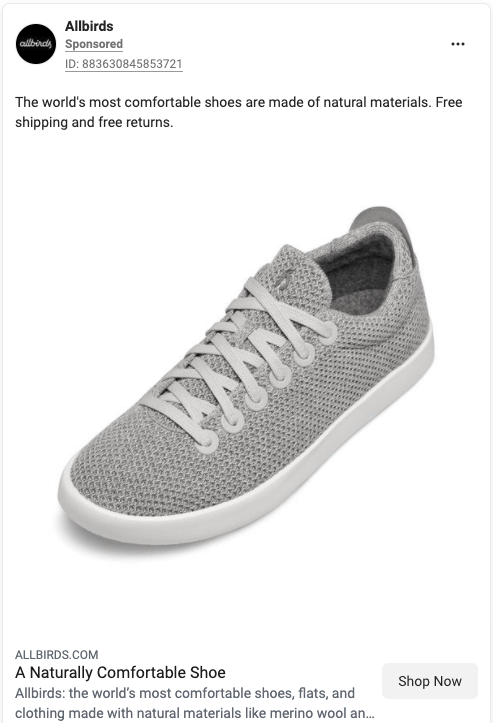 And now take a look at this Christmas-themed newsletter, which leads with the idea of sending Allbirds products as gifts, before reverting to those same core messages — how those products are light, comfy, and made from natural materials:
And now take a look at this Christmas-themed newsletter, which leads with the idea of sending Allbirds products as gifts, before reverting to those same core messages — how those products are light, comfy, and made from natural materials:

It’s not rocket science; it’s just about finding your niche, understanding your audience, honing your messaging, and sticking with it when you’ve discovered what works.
2. Apple
It’s not exactly breaking news that Apple is good at marketing.
According to Interbrand, it’s the most valuable brand in the world, with a value of almost $323 billion. That’s approximately double the value of third-placed Microsoft, which is hardly a slouch in the marketing stakes.
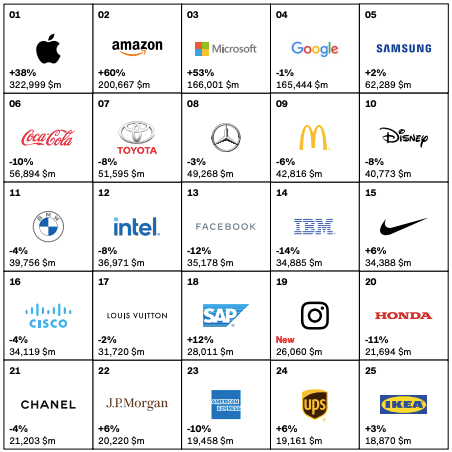 There are lots of reasons why Apple’s brand is so strong—far too many to go into here. But one of the key aspects lies in its unique approach to blending digital channels with physical retail stores.
There are lots of reasons why Apple’s brand is so strong—far too many to go into here. But one of the key aspects lies in its unique approach to blending digital channels with physical retail stores.
A lot of high street retailers treat the online and offline worlds as near-separate channels. Others prefer to drive online shoppers in-store via services such as click-and-collect.
Ever the innovator, Apple has done things entirely differently by making the in-store experience all about education and customer service rather than sales.
Because Apple stores are such low-pressure environments, consumers feel more compelled to visit them, try out new Apple products, and speak to Apple Geniuses (or Genii?). And the more they do that, the more they buy into the brand.
3. ASOS
“Multichannel” doesn’t exclusively refer to totally different online (and offline) environments.
It can just as accurately be used to discuss how brands operate across multiple social channels.
As we all know, different social platforms have very different audiences. You’d expect LinkedIn to have a different audience to TikTok, and for people to use the platforms in different ways.
But it’s equally true for platforms that aren’t so obviously different.
For instance, consider Instagram and Twitter. They have lots in common — both are beloved by brands; both are pretty visual; both have big influencer communities.
However, their user bases are quite different, as demonstrated by data from Sprout Social. Instagram skews females, and its largest age group is 25-34. Twitter, on the other hand, has an overwhelmingly male audience, while its largest age group is significantly older at 30-49.
So it stands to reason that brands should alter their approach across those two channels. Which is exactly what ASOS does.
Here’s a pretty solid example of a tweet from the fashion e-commerce giant:
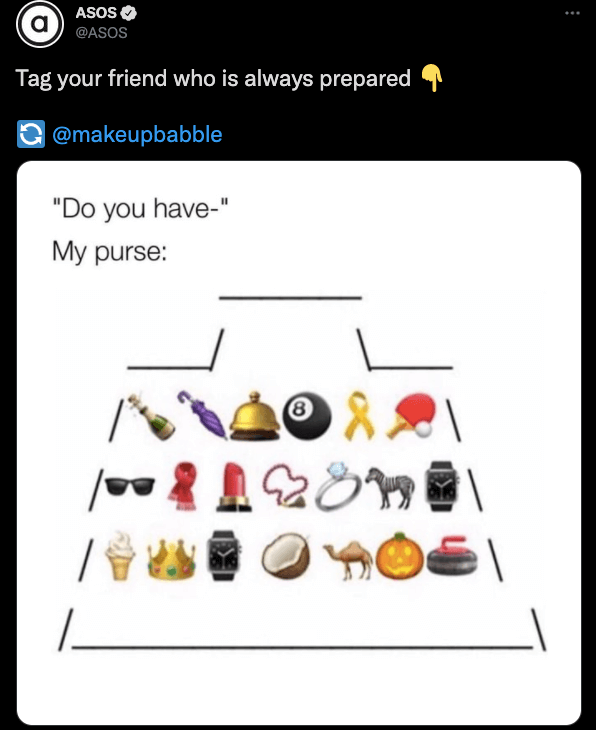 It’s visual and relatable, while also broadly tying into the brand’s market and products.
It’s visual and relatable, while also broadly tying into the brand’s market and products.
In other words, it’s pretty much exactly what you’d expect from ASOS.
Now, let’s take a look at one of its Instagram posts:
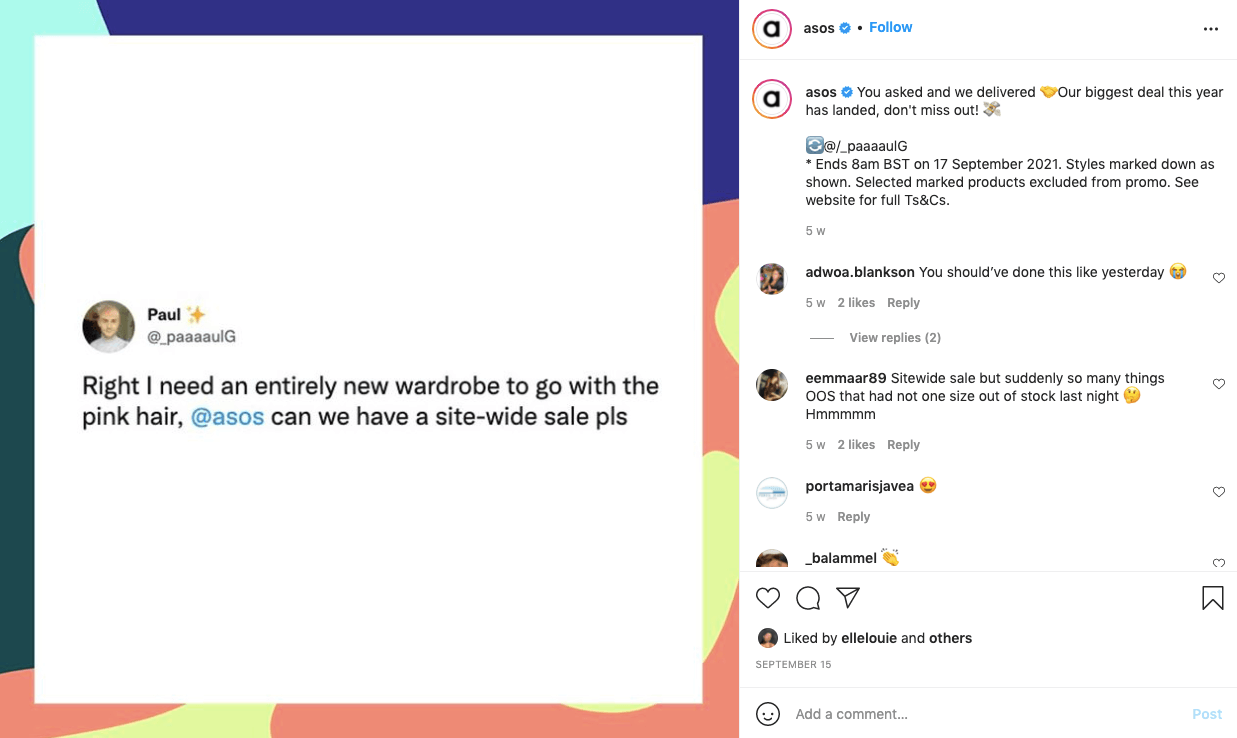 While it’s still aiming for that relatable, casual feel, this post is clearly a lot more “salesy” (since it’s promoting a site-wide discount). That makes sense because Instagram feels like a more sales-driven environment than Twitter.
While it’s still aiming for that relatable, casual feel, this post is clearly a lot more “salesy” (since it’s promoting a site-wide discount). That makes sense because Instagram feels like a more sales-driven environment than Twitter.
This is reflected by data from HubSpot, which shows that Instagram delivers the highest ROI of any social platform other than Facebook:
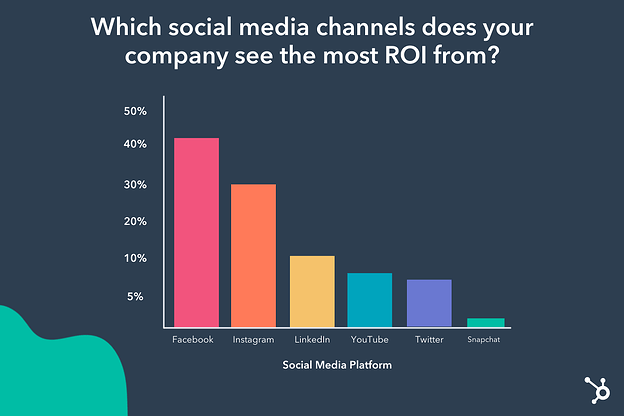
4. Under Armour
Just as the term “multichannel” can relate to marketing across different social platforms, it can also refer to using the same platform through organic posting and paid media.
Even within the same social network, paid and organic can be different “channels”.
Think about it: when you’re scrolling through Facebook (or Instagram, or Twitter, or any other platform), you’re specifically looking for posts from the people and brands you choose to follow.
When you see those posts, there’s a comparatively good chance you’ll engage because you know—and maybe even like—the people or corporate entities that posted them.
On the other hand, social ads are interruptive. Often, we don’t follow the brands who advertise to us. A lot of the time, we’ll never even have heard of them.
For that reason, paid media is almost always more sales-oriented, whereas organic posting is more about generating engagement and loyalty among people who are already bought into your brand.
Clearly, those two “goals” are quite different.
So it’s no surprise that many brands struggle to make their organic and paid social activity feel consistent—which, as I’ve already discussed, is a key element of high-quality multichannel marketing.
Under Armour is one brand that gets it exactly right.
Admittedly, as a household name, it has a distinct advantage over your average e-commerce company. Whether or not you follow Under Armour’s social channels, chances are you’re at least somewhat familiar with what it does. And if you aren’t, you likely won’t be part of its target audience anyway.
Still, that’s no guarantee of success. So what does Under Armour do well?
Just like Allbirds, the brand clearly understands what its audience wants.
Much of its marketing hinges on the fact that high-profile sportspeople across multiple disciplines use its products.
In its paid activity, that translates to highlighting its collaborations and promoting specific product ranges:
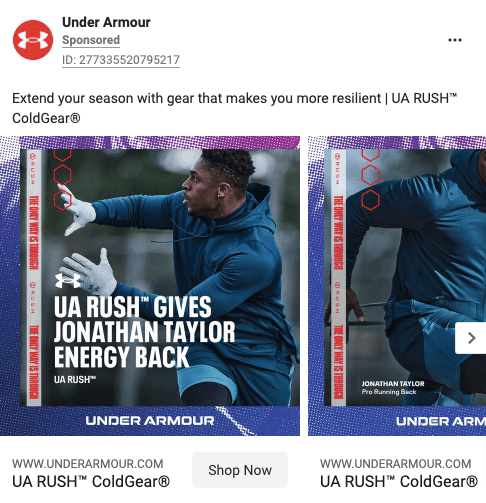 In contrast, Under Armour’s organic posts are far less promotional. Rather than attempting to directly drive sales, they often tell the story of athletes who use Under Armour products. The products themselves are barely mentioned, if at all. Here’s a good example, featuring long-distance runner Weini Kelati:
In contrast, Under Armour’s organic posts are far less promotional. Rather than attempting to directly drive sales, they often tell the story of athletes who use Under Armour products. The products themselves are barely mentioned, if at all. Here’s a good example, featuring long-distance runner Weini Kelati:
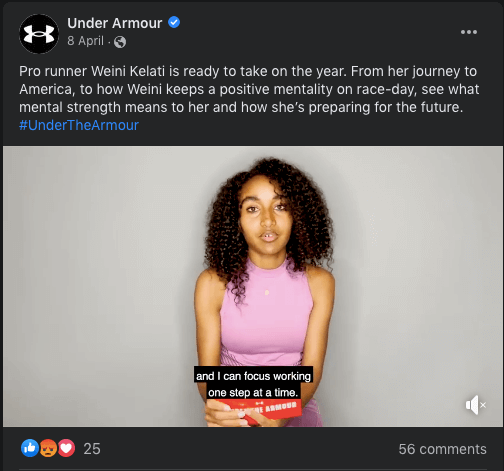 That makes for a much more engaging experience. After all, when I follow a brand, I don’t just want to see a bunch of adverts masquerading as organic posts—I want to see content that educates and entertains me.
That makes for a much more engaging experience. After all, when I follow a brand, I don’t just want to see a bunch of adverts masquerading as organic posts—I want to see content that educates and entertains me.
So, without wishing to labor the point, consistency is important. But consistency doesn’t mean doing the exact same thing across every channel, regardless of what the audience for each channel wants to see.
5. Sephora
It’s no secret that e-commerce brands love Instagram.
The reasons why are obvious: it’s one of the most effective platforms for connecting with shoppers. Indeed, Instagram’s own data shows that 90 percent of users follow a business account. What’s more, 50 percent of consumers say they feel more interested in a brand after seeing ads for it on the platform.
However, there’s an obvious problem with Instagram: the whole link-in-bio thing. Unless you’re allowing customers to buy from within the Instagram app, it can be difficult to create a unified, multichannel shopping experience that starts on Instagram and ends with a purchase.
That’s a major issue for a company like Sephora, which has almost 21 million Instagram followers—and no doubt wants to monetize those followers.
Fortunately, tools like Linktree and LikeShop offer a simple solution to this challenge. They allow brands to transport shoppers from an Instagram profile or post…
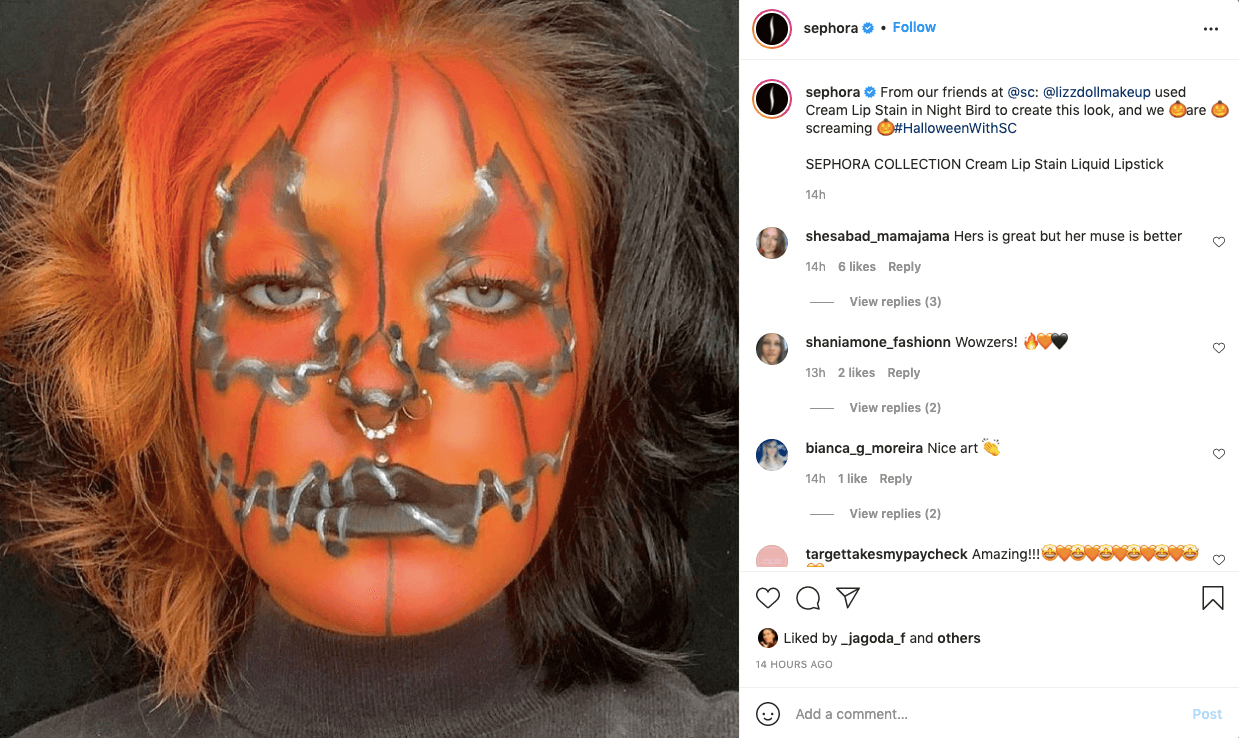 …straight to the relevant product page:
…straight to the relevant product page:
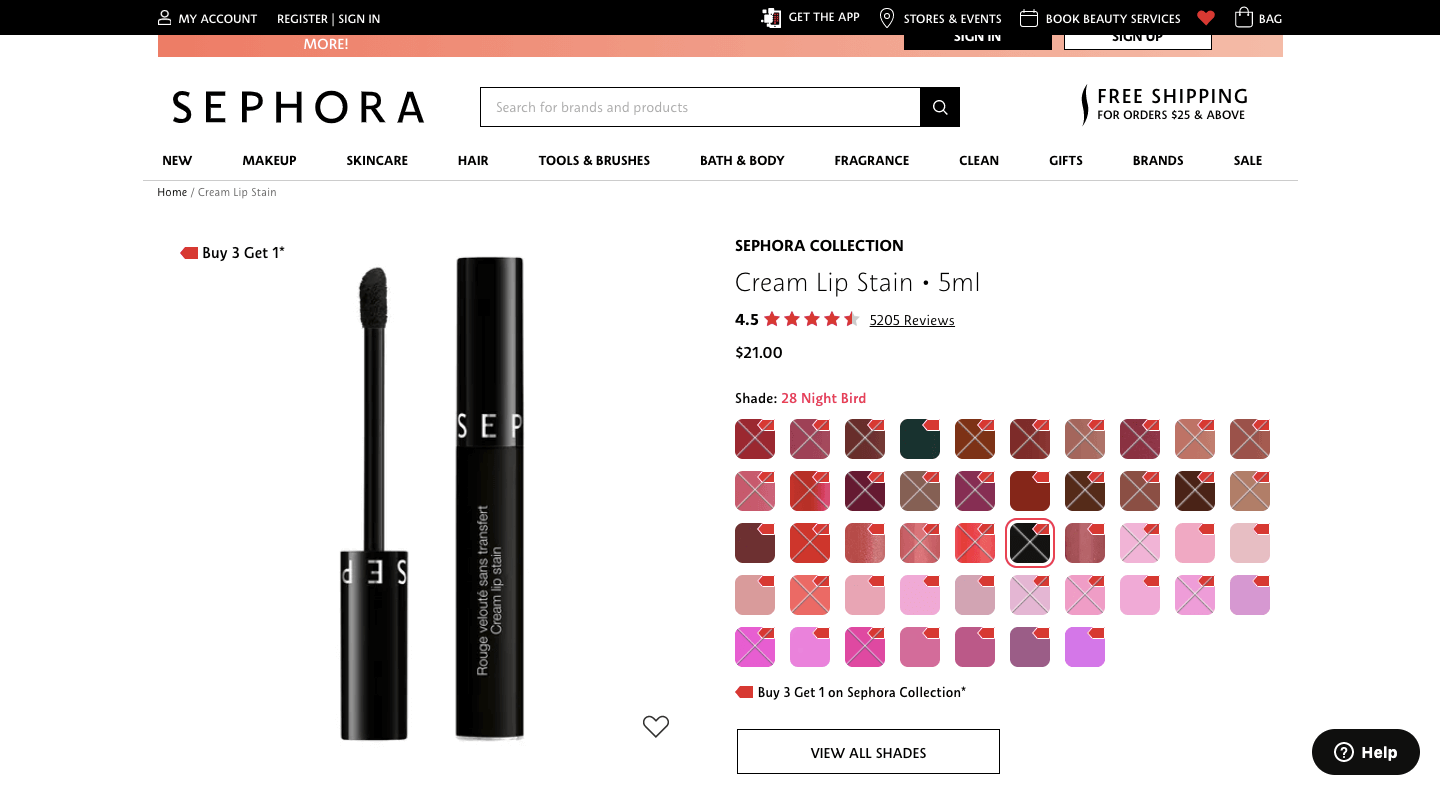 This is a simple and highly effective example of multichannel marketing in action because it does what all good marketing should do. It reaches the customer with a compelling message and a product they want to buy, then makes it simple for them to convert.
This is a simple and highly effective example of multichannel marketing in action because it does what all good marketing should do. It reaches the customer with a compelling message and a product they want to buy, then makes it simple for them to convert.

Conclusion
Like so many other things in marketing, multichannel campaigns sound complicated but are actually simple.
Ultimately, it boils down to finding a message that resonates with audiences across several channels, then tailoring your language, visuals, calls to action, and other key elements to each individual platform. You don’t need to be a genius to get it right; you just need to put the work in.
When you understand your audience and know which channels they like to use for which purposes, the rest becomes easy.
Regardless of which channels you choose for that multichannel strategy, email is likely going to be your most important one. We already know that email drives more revenue than any other channel because your contacts have already manifested intent to buy.
Investing in email as a channel means more work. But it doesn’t have to be difficult. Drip can help you streamline your email through marketing automation — meaning you can reach even more customers in less time.
But don’t take my word for it — try Drip free for 14 days and see for yourself!
